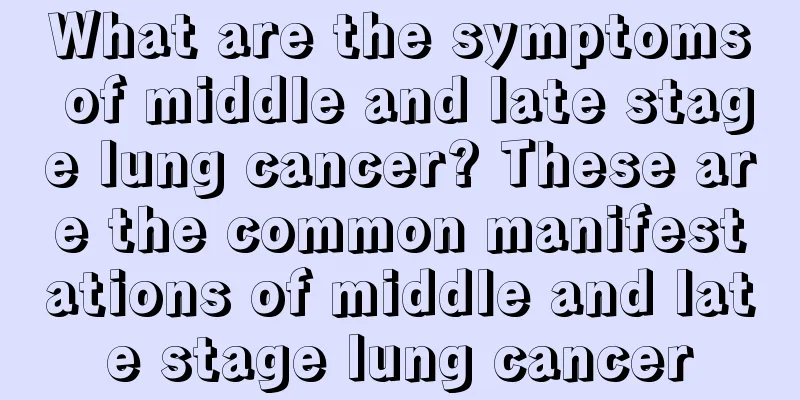What are the symptoms of middle and late stage lung cancer? These are the common manifestations of middle and late stage lung cancer

|
What are the symptoms of mid- to late-stage lung cancer? Once lung cancer is diagnosed, it is often in the mid- to late-stage. Some patients may not have obvious symptoms when they are first diagnosed, but as the disease progresses, the discomfort of the body will gradually increase. So what are the symptoms of mid- to late-stage lung cancer? In general, the symptoms of mid- and late-stage lung cancer vary depending on the patient's physical condition. Lung cancer is more serious in the late stage and requires timely symptomatic treatment. Common symptoms of mid- and late-stage lung cancer are: Chest pain: The chest cavity is a very complex space. Three-quarters of the lung surface is surrounded by the chest wall, which is composed of a thin layer of lining (parietal pleura), fat, muscle, ribs and skin in different proportions. Tumor invasion of any of the above parts will cause pain. Therefore, most patients with lung cancer that have regionally spread to the chest have symptoms of chest pain. Hoarseness: It is the most common symptom of patients with advanced lung cancer. The recurrent laryngeal nerve that controls the left side of the voice function goes down from the neck to the chest, bypasses the large blood vessels of the heart and goes back up to the larynx, thus controlling the left side of the voice organ. Therefore, if the tumor invades the left side of the mediastinum and compresses the recurrent laryngeal nerve, hoarseness will occur, but there will be no sore throat or other symptoms of upper respiratory tract infection. Shortness of breath, pleural effusion: Almost all patients with advanced lung cancer that has spread regionally have shortness of breath to varying degrees. Normal tissue fluid produced by the lungs and myocardium is returned by the lymph nodes in the middle of the chest. If these lymph nodes are blocked by tumors, this tissue fluid will accumulate in the pericardium to form pericardial effusion or accumulate in the chest cavity to form pleural effusion. Both of the above situations can cause shortness of breath. Facial and neck edema. On the right side of the mediastinum is the superior vena cava, which transports venous blood from the upper limbs and head and neck back to the heart. If the tumor invades the right side of the mediastinum and compresses the superior vena cava, it will initially cause the jugular vein to become swollen due to poor blood return, and eventually lead to facial and neck edema, which needs to be diagnosed and treated in a timely manner. The appearance of symptoms of mid- to late-stage lung cancer will seriously affect the quality of life of lung cancer patients, especially those in the late stage. The physical pain and psychological torture will weaken people's willpower and make them lose confidence in defeating the disease. Relieving the symptoms of mid- to late-stage lung cancer as soon as possible can not only improve the physical condition of patients, but also enable patients to build confidence in defeating the disease and actively cooperate with treatment, thus producing good treatment effects. |
>>: What are the causes of lung cancer? Five factors are likely to cause lung cancer
Recommend
How to quickly remove the smell of shoes_How to permanently remove the smell of shoes_How to remove the feces smell of slippers How to quickly remove the smell of shoes?
In daily life, many people are prone to having ba...
What to do if you suddenly feel dizzy
With the faster and faster development of moderni...
Is bladder cancer contagious in the elderly?
Bladder cancer is a common male disease. Patients...
Imaging examination methods for nasopharyngeal carcinoma
Nasopharyngeal carcinoma occurs in deep parts of ...
Minimally invasive surgery process for rhinitis
Most rhinitis drugs can only control the conditio...
What is the effective way to eliminate chicken skin?
In fact, many friends are quite disgusted by the ...
Criteria for judging cardiac and respiratory arrest
The criteria for judging cardiac and respiratory ...
What are soy isoflavones and what are their functions
Many people don’t know much about the effects of ...
Surgical treatment can be selected for clinical treatment of lung cancer
The treatment of lung cancer is very important, b...
What are the tricks to deal with black spots on towels
The black spots on towels are mainly caused by mi...
What to eat to prevent stomach cancer
What to eat to prevent stomach cancer? In order t...
Will eating apples make you fat? It turns out this is the case
Apple is widely recognized as a holy product for ...
Breastfed babies have very smelly stools, what is the reason?
The feces of babies who are breastfed for a long ...
Is it good to drink Chinese medicine in dog days
In summer, high temperatures occur in most parts ...
What are the magical uses of vinegar
I believe most people know vinegar. However, many...









